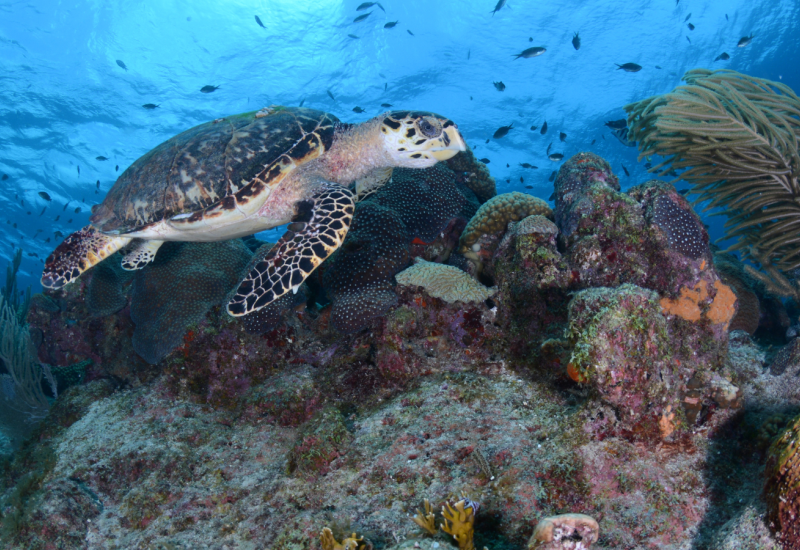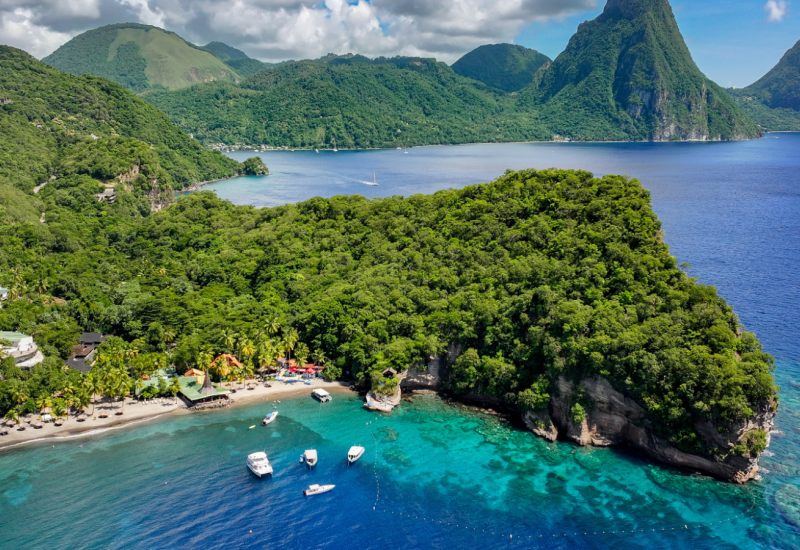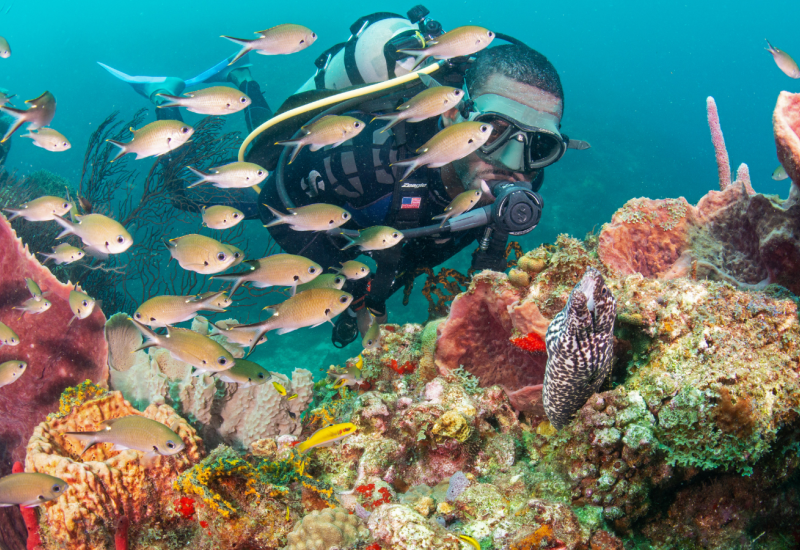Southern California Nights

March 2007
By Ed Weber
Photography by Stuart Westmorland
For most people, the thought of a hot California night at the beach conjures images of bikini-clad surfers watching the sun set over the Pacific. But on many Southern California shores, a different scenario takes place at dusk. When twilight comes, groups of avid divers pull into parking lots up and down the coast, driving SUVs packed with dive gear. They come to experience what's really hot about SoCal beaches: night diving.
Of course, before they can enjoy the water, they have to get there. And this being traffic-jammed California, that's not always as easy as it sounds. My recent dive trip to the LA area began with me and my buddy, photographer Stuart Westmorland, sitting in rush-hour traffic, trying to understand the robotic directions emanating from our rental car's GPS unit.
Exhaust fumes and impatient commuters were conspiring to ruin our evening. But the GPS unit guided us through the chaos, and we popped into a quaint seaside borough. We wound our way through narrow streets and turned into the Veterans Park lot at Redondo Beach, just as the setting sun began to stain the sky a brilliant pink-orange.
We had heard that many of the beaches along Southern California's coast--considered dull underwater sand deserts by day--are transformed into active, marine-life festivals with the setting sun. Sensing that we had stumbled into the Las Vegas of night dive sites, we decided to see what this spot had to offer.
Redondo Beach
Veterans Park in Redondo Beach, about eight miles south of Los Angeles, is a sandy-bottom site that is popular for checkout dives. It is also an easily accessible site for local night divers. From the parking lot, you descend to the beach via 68 (yes, I counted) steps, which can be a bit of a challenge in full dive gear. A long, 75-yard swim straight out from the stairs leads to the yawning rim of the Redondo Canyon. Depths drop from 40 feet to abysmal.
Late fall and early winter bring massive runs of opalescent squid along the canyon walls. The squid overrun the canyon in a frenzy of reproduction, laying vast carpets of white tubular egg casings. Predators often track and follow the squid into the canyon. Bonito, bat rays, blue sharks and sea lions are sometimes spotted, speeding in from the ink-black depths to knock off an easy meal. Within three to five weeks, small juvenile squid hatch from the eggs and head out to the open ocean. They will return to this same canyon in three years to repeat the reproduction cycle once again.
At the southern edge of the beach, another popular dive site can be found where an old jetty forms a rocky structure. A healthy population of local denizens, including octopus, sculpin and a host of crustaceans, can be found in and around the rock piles. The pier and harbor area to the north, although tempting, is now off-limits to divers. (One of the effects of the post-9/11 era on divers has been the unfortunate closing of many popular diving areas. At present, it's a good idea to check with local authorities when considering diving in an unfamiliar area.)
La Jolla Shores
The next day, we headed south to San Diego. We planned to make a night dive at La Jolla Shores, a long stretch of sandy beach just south of the Scripps Institution of Oceanography Pier. Although the pilings might offer interesting diving, the main attraction here is a deep submarine canyon that runs roughly parallel to the shoreline. The entire canyon complex is part of the San Diego-La Jolla Underwater Park Ecological Reserve.
We made a beach entry into gentle surf and dropped in for a 100-yard swim across sloping sand flats. A scattering of sand dollars across the seabed glistened in our light beams. As darkness fell, the aquatic desert came to life. As we coasted overhead, a guitarfish finned off the bottom, kicking up sand and giving a snow globe-like quality to our corridor of light. We spotted a variety of other inhabitants in the sand: Skates and rays shed their sand blankets and fluttered off as cusk eels buried themselves tail-first in a defensive posture. We descended along a 20-foot bottom and rode the tide over the sandstone escarpment and into the black canyon. The sheer drop of the chasm caused me to check my depth and buoyancy. This was warranted in the dark, with the bottom rising some 800 feet below us. Our light beams revealed numerous grottoes carved into the walls.
The squid have long since left this canyon, but their remaining egg cases glistened like alien flowers emerging from the sandstone. The walls were alive with small inverts, crustaceans and filter feeders. An array of fish was hiding in the back grottoes of the crevices; I recognized juvenile rockfish, cabezon, gobies and sculpin. As my light beam disturbed their slumber, they attempted to wriggle out of sight. Tiny bioluminescent medusa jellyfish squirted by our masks in the current. The staccato bursts of Stuart's flash as he photographed the wall left vivid imprints in the recesses of my brain: I could close my eyes and see colored images of nudibranchs, gorgonians and seapens. Abruptly, Stuart interrupted my reverie and motioned: time to head up. We finned up and over the canyon rim and ran an easy compass line back to shore.
The underwater canyon system here is complex, bisecting the bay with branches making up the La Jolla Canyon as well as the deeper Scripps Canyon north of the pier. Diving Scripps Canyon is best done with a charter boat, to avoid a long surface swim and potential current. Upwellings from the ocean's depths flood this canyon with cold water and rich nutrients. Amazingly, these upwellings support a community of cold-water species not commonly found in Southern California. You might be surprised to find a wolf eel hiding in a crevice here.
Catalina After Dark
Another great spot for night dives in Southern California is Catalina Island. Although there are no car ferries to the island, there are several high-speed passenger ferries that depart from terminals near Los Angeles and Long Beach. Simply park and enjoy the quick 90-minute ride to Avalon. Schedules, prices and availability vary depending on the time of year.
Once in Avalon, don't miss the Casino Point Underwater Park, a 10-minute walk from the center of town. The dive area extends from the front of the casino to the end of the breakwater, with depths averaging 40 to 50 feet. The entry here is one of the easiest in all Southern California, with manageable stairs that descend straight into the water. Numerous wrecks, rocky reefs and kelp beds provide habitat for rockfish, garibaldi, sheephead and the occasional moray eel. A first-rate dive site by day, the Underwater Park takes on a surreal quality at night, with a variety of creatures swimming through the atmospheric stands of kelp. And topside, the nighttime views of the surrounding harbor lights are stunning.
InDepth
Veterans Park, Redondo Beach
Location: Veterans Park is a few blocks from the intersection of the Pacific Coast Hwy. and Torrance Blvd., just south of the Redondo Beach Pier. Veterans Park has a large parking lot (bring plenty of quarters for the parking meters as they're in effect 24 hours a day, seven days a week, including weekends).
Access and Entry: Take the stairs a short distance from the parking lot. The stairs have handrails to assist divers. The sandy beach entry is south of the Redondo Beach Pier (no diving at the pier).
Water Conditions: Water temps are in the upper 40s to low 50s in winter and in the upper 60s in late summer. Depths range from 15 to 40 feet on the sandy bottom, 40 to 80 feet on the canyon wall. Deeper beyond.
Skill Level: Beach diving experience in small surf to the lip of the canyon. More experience needed in the canyon.
La Jolla Shores
Location: The La Jolla Submarine Canyon is located adjacent to the city of La Jolla, north of Mission Bay and San Diego.
Access and Entry: The canyon reaches almost to the beach and can be accessed from shore at the well-known dive and swimming area known as La Jolla Shores at the foot of Valicitos St. A 350-space parking lot is located at the foot of Calle Frescota next to the lifeguard tower. In summer, this lot fills to capacity by mid-day. Limited on-street parking may be available.
Water Conditions: Water temps range from low 50s in winter to upper 60s in late summer. The sand bottom slopes steeply from about 30 feet to depths well beyond recreational dive limits. Visibility varies depending on upwellings and sometimes-strong currents. Spring and winter weather can reduce visibility.
Skill Level: All levels to the lip of the canyon. In the canyon, intermediate to advanced divers.
Casino Point Underwater Park, Catalina Island
Location: On the northwest end of the resort town of Avalon. The park is named for the Casino, a landmark building that's adjacent to the park.
Access and Entry: Although some divers make the trip by private boat, the majority arrive by passenger ferry. The 149-passenger Catalina Express makes the trip in just over one hour from the harbor at either San Pedro or Long Beach, departing almost hourly from early morning through evening. Although tank and equipment rentals are available from the two dive centers in Avalon, most divers bring all their own gear, including a tank. Tank racks are provided on the deck of the ferry. The Casino is about a 10-minute walk from the ferry docks. Gearing up is done just behind the low wall lining the breakwater, and on busy days (it's a popular place for open-water checkout dives), the paving stones become a staging area for equipment assembly. Catalina Divers Supply has the concession to supply on-site air fills at the Point. Restroom facilities are in the Casino, and public showers are a few minutes' walk toward the center of town.
Water Conditions: In late summer, water temps are in the high 60s and drop to the mid-50s in winter. Because it faces the California coast rather than the open ocean, Casino Point typically has negligible current with flat or gently rolling surface conditions. The perimeter of the dive area is marked by a string of white buoys, protecting divers from boaters.
Skill Level: All levels.

March 2007
By Ed Weber
Photography by Stuart Westmorland
For most people, the thought of a hot California night at the beach conjures images of bikini-clad surfers watching the sun set over the Pacific. But on many Southern California shores, a different scenario takes place at dusk. When twilight comes, groups of avid divers pull into parking lots up and down the coast, driving SUVs packed with dive gear. They come to experience what's really hot about SoCal beaches: night diving.
Of course, before they can enjoy the water, they have to get there. And this being traffic-jammed California, that's not always as easy as it sounds. My recent dive trip to the LA area began with me and my buddy, photographer Stuart Westmorland, sitting in rush-hour traffic, trying to understand the robotic directions emanating from our rental car's GPS unit.
Exhaust fumes and impatient commuters were conspiring to ruin our evening. But the GPS unit guided us through the chaos, and we popped into a quaint seaside borough. We wound our way through narrow streets and turned into the Veterans Park lot at Redondo Beach, just as the setting sun began to stain the sky a brilliant pink-orange.
We had heard that many of the beaches along Southern California's coast--considered dull underwater sand deserts by day--are transformed into active, marine-life festivals with the setting sun. Sensing that we had stumbled into the Las Vegas of night dive sites, we decided to see what this spot had to offer.
Redondo Beach
Veterans Park in Redondo Beach, about eight miles south of Los Angeles, is a sandy-bottom site that is popular for checkout dives. It is also an easily accessible site for local night divers. From the parking lot, you descend to the beach via 68 (yes, I counted) steps, which can be a bit of a challenge in full dive gear. A long, 75-yard swim straight out from the stairs leads to the yawning rim of the Redondo Canyon. Depths drop from 40 feet to abysmal.
Late fall and early winter bring massive runs of opalescent squid along the canyon walls. The squid overrun the canyon in a frenzy of reproduction, laying vast carpets of white tubular egg casings. Predators often track and follow the squid into the canyon. Bonito, bat rays, blue sharks and sea lions are sometimes spotted, speeding in from the ink-black depths to knock off an easy meal. Within three to five weeks, small juvenile squid hatch from the eggs and head out to the open ocean. They will return to this same canyon in three years to repeat the reproduction cycle once again.
At the southern edge of the beach, another popular dive site can be found where an old jetty forms a rocky structure. A healthy population of local denizens, including octopus, sculpin and a host of crustaceans, can be found in and around the rock piles. The pier and harbor area to the north, although tempting, is now off-limits to divers. (One of the effects of the post-9/11 era on divers has been the unfortunate closing of many popular diving areas. At present, it's a good idea to check with local authorities when considering diving in an unfamiliar area.)
La Jolla Shores
The next day, we headed south to San Diego. We planned to make a night dive at La Jolla Shores, a long stretch of sandy beach just south of the Scripps Institution of Oceanography Pier. Although the pilings might offer interesting diving, the main attraction here is a deep submarine canyon that runs roughly parallel to the shoreline. The entire canyon complex is part of the San Diego-La Jolla Underwater Park Ecological Reserve.
We made a beach entry into gentle surf and dropped in for a 100-yard swim across sloping sand flats. A scattering of sand dollars across the seabed glistened in our light beams. As darkness fell, the aquatic desert came to life. As we coasted overhead, a guitarfish finned off the bottom, kicking up sand and giving a snow globe-like quality to our corridor of light. We spotted a variety of other inhabitants in the sand: Skates and rays shed their sand blankets and fluttered off as cusk eels buried themselves tail-first in a defensive posture. We descended along a 20-foot bottom and rode the tide over the sandstone escarpment and into the black canyon. The sheer drop of the chasm caused me to check my depth and buoyancy. This was warranted in the dark, with the bottom rising some 800 feet below us. Our light beams revealed numerous grottoes carved into the walls.
The squid have long since left this canyon, but their remaining egg cases glistened like alien flowers emerging from the sandstone. The walls were alive with small inverts, crustaceans and filter feeders. An array of fish was hiding in the back grottoes of the crevices; I recognized juvenile rockfish, cabezon, gobies and sculpin. As my light beam disturbed their slumber, they attempted to wriggle out of sight. Tiny bioluminescent medusa jellyfish squirted by our masks in the current. The staccato bursts of Stuart's flash as he photographed the wall left vivid imprints in the recesses of my brain: I could close my eyes and see colored images of nudibranchs, gorgonians and seapens. Abruptly, Stuart interrupted my reverie and motioned: time to head up. We finned up and over the canyon rim and ran an easy compass line back to shore.
The underwater canyon system here is complex, bisecting the bay with branches making up the La Jolla Canyon as well as the deeper Scripps Canyon north of the pier. Diving Scripps Canyon is best done with a charter boat, to avoid a long surface swim and potential current. Upwellings from the ocean's depths flood this canyon with cold water and rich nutrients. Amazingly, these upwellings support a community of cold-water species not commonly found in Southern California. You might be surprised to find a wolf eel hiding in a crevice here.
Catalina After Dark
Another great spot for night dives in Southern California is Catalina Island. Although there are no car ferries to the island, there are several high-speed passenger ferries that depart from terminals near Los Angeles and Long Beach. Simply park and enjoy the quick 90-minute ride to Avalon. Schedules, prices and availability vary depending on the time of year.
Once in Avalon, don't miss the Casino Point Underwater Park, a 10-minute walk from the center of town. The dive area extends from the front of the casino to the end of the breakwater, with depths averaging 40 to 50 feet. The entry here is one of the easiest in all Southern California, with manageable stairs that descend straight into the water. Numerous wrecks, rocky reefs and kelp beds provide habitat for rockfish, garibaldi, sheephead and the occasional moray eel. A first-rate dive site by day, the Underwater Park takes on a surreal quality at night, with a variety of creatures swimming through the atmospheric stands of kelp. And topside, the nighttime views of the surrounding harbor lights are stunning.

InDepth
Veterans Park, Redondo Beach
Location: Veterans Park is a few blocks from the intersection of the Pacific Coast Hwy. and Torrance Blvd., just south of the Redondo Beach Pier. Veterans Park has a large parking lot (bring plenty of quarters for the parking meters as they're in effect 24 hours a day, seven days a week, including weekends).
Access and Entry: Take the stairs a short distance from the parking lot. The stairs have handrails to assist divers. The sandy beach entry is south of the Redondo Beach Pier (no diving at the pier).
Water Conditions: Water temps are in the upper 40s to low 50s in winter and in the upper 60s in late summer. Depths range from 15 to 40 feet on the sandy bottom, 40 to 80 feet on the canyon wall. Deeper beyond.

Skill Level: Beach diving experience in small surf to the lip of the canyon. More experience needed in the canyon.
La Jolla Shores
Location: The La Jolla Submarine Canyon is located adjacent to the city of La Jolla, north of Mission Bay and San Diego.
Access and Entry: The canyon reaches almost to the beach and can be accessed from shore at the well-known dive and swimming area known as La Jolla Shores at the foot of Valicitos St. A 350-space parking lot is located at the foot of Calle Frescota next to the lifeguard tower. In summer, this lot fills to capacity by mid-day. Limited on-street parking may be available.
Water Conditions: Water temps range from low 50s in winter to upper 60s in late summer. The sand bottom slopes steeply from about 30 feet to depths well beyond recreational dive limits. Visibility varies depending on upwellings and sometimes-strong currents. Spring and winter weather can reduce visibility.
Skill Level: All levels to the lip of the canyon. In the canyon, intermediate to advanced divers.
Casino Point Underwater Park, Catalina Island
Location: On the northwest end of the resort town of Avalon. The park is named for the Casino, a landmark building that's adjacent to the park.

Access and Entry: Although some divers make the trip by private boat, the majority arrive by passenger ferry. The 149-passenger Catalina Express makes the trip in just over one hour from the harbor at either San Pedro or Long Beach, departing almost hourly from early morning through evening. Although tank and equipment rentals are available from the two dive centers in Avalon, most divers bring all their own gear, including a tank. Tank racks are provided on the deck of the ferry. The Casino is about a 10-minute walk from the ferry docks. Gearing up is done just behind the low wall lining the breakwater, and on busy days (it's a popular place for open-water checkout dives), the paving stones become a staging area for equipment assembly. Catalina Divers Supply has the concession to supply on-site air fills at the Point. Restroom facilities are in the Casino, and public showers are a few minutes' walk toward the center of town.
Water Conditions: In late summer, water temps are in the high 60s and drop to the mid-50s in winter. Because it faces the California coast rather than the open ocean, Casino Point typically has negligible current with flat or gently rolling surface conditions. The perimeter of the dive area is marked by a string of white buoys, protecting divers from boaters.
Skill Level: All levels.











